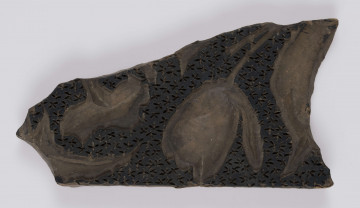
Block for printing on textile
1901 — 1950
National Museum in Lublin
Part of the collection: Fabric printing matrices
For centuries people have been decorating textiles by printing patterns with different kinds of stamps, from very simple potato stamps to specially carved wooden blocks with intricate designs. The fabrics were printed with two techniques. The first one involved the direct imprinting of a design on the fabric from a block covered with paint, while the second one involved the imprinting of an insulating mass on the fabric to protect the covered areas from the effects of the dye. Both methods have most probably equally long history, but the second one, called batik printing, has been popularized in Europe only in the 17th century. The presented stamp has a floral ornament made with woodcarving technique and brass pins hammered into the wood. The main, recurring motif on the stamp is a calicular flower drawn from the side. Considering the popularity of Orientalism in Europe in the 18th and 19th centuries, it could have been a lotus flower. In many cultures of the Far East, it has a rich symbolic meaning. Presumably, the stamp was used in one of the local printing shops which operated in Pomerania in the 19th century. Its products, thanks to their durability and elegance were considerably popular, but eventually, they were superseded by fabrics produced by the modern textile industry.
Author / creator
Dimensions
cały obiekt: height: 5,2 cm, width: 18,7 cm
Object type
matrix
Creation time / dating
Creation / finding place
Identification number
Location / status

1901 — 1950
National Museum in Lublin

1901 — 1950
National Museum in Lublin

1901 — 1950
National Museum in Lublin
DISCOVER this TOPIC
National Museum in Lublin
DISCOVER this PATH
Educational path